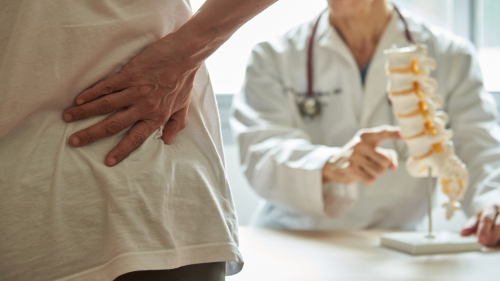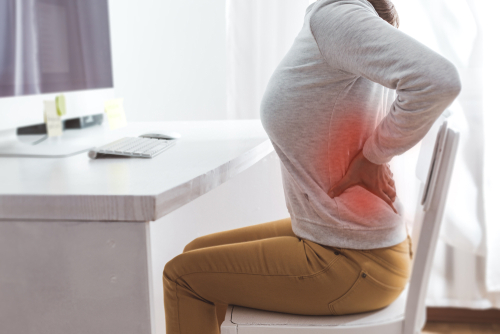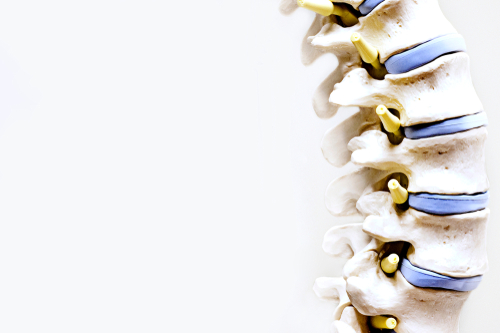
Herniated Discs: Diagnosis and Treatment Strategies
October 3, 2023
Yoga and Pilates for Spinal Health: Effective Exercises
December 2, 2023Common Causes of Back Pain: An In-Depth Analysis

Common Causes of Back Pain An In-Depth Analysis
Common Causes of Back Pain: An In-Depth Analysis. With an estimated 80% of people experiencing back pain at some point in their lives, it’s a pervasive issue that ranges from mild discomfort to debilitating pain.
Understanding the root causes of back pain can aid in more effective treatment and prevention strategies.
This article offers a comprehensive, detailed guide to the various causes of back pain, aiming to empower you with the knowledge to take control of your health.
Table of Contents
The Anatomy of the Back: A Quick Look
The vertebral column, commonly referred to as the spine, consists of 33 vertebrae. These are categorized into five regions: cervical, thoracic, lumbar, sacral, and coccygeal.
Between the vertebrae are intervertebral discs, composed of an outer ring of fibrous cartilage and a jelly-like core, providing cushioning and flexibility.
Muscles and Ligaments That Support the Back
The back muscles are categorized into three groups: superficial, intermediate, and deep. Each of these groups plays a unique role in spinal movement and stabilization.
Ligaments such as the anterior longitudinal ligament and posterior longitudinal ligament bind the vertebrae together, offering additional support.
How the Back Works in Everyday Activities
Whether it’s lifting a bag, sitting at a desk, or walking, the back engages in a complex interplay of muscular contraction and relaxation, vertebral alignment, and disc compression and decompression.
This synergy allows us to carry out activities effortlessly. Any disruption in these mechanics can result in back pain.
Lifestyle Causes of Back Pain

Lack of Exercise and Core Weakness
Core muscles, including the rectus abdominis, obliques, and erector spinae, play a crucial role in maintaining spinal integrity. A weakened core fails to offer adequate spinal support, leading to uneven stress distribution and subsequent back pain.
Sedentary Lifestyle and Back Pain
A lifestyle characterized by prolonged periods of sitting contributes to muscle atrophy and stiffness. Over time, this creates a biomechanical environment conducive to back pain.
Role of Core Muscles in Supporting the Back
The core muscles stabilize the spine, allowing it to bear weight and facilitate movement. A strong core is synonymous with a healthy back, as it can effectively neutralize the daily stresses exerted on the spine.
Poor Posture
Bad Habits That Lead to Poor Posture
Poor posture can stem from bad habits such as slouching, not setting up an ergonomic workstation, and excessive time on handheld devices. These behaviors contribute to muscle imbalances, vertebral misalignment, and, eventually, back pain.
Biomechanics of Poor Posture and Back Pain
A poorly aligned spine disrupts the natural curvature, resulting in uneven body weight distribution. This adds extra stress to the intervertebral discs and can lead to conditions like herniated discs or pinched nerves.
Work-Related Causes

Ergonomic factors, including chair height, monitor level, and keyboard placement, directly affect spinal alignment. Poor ergonomic setup results in an unnatural sitting posture, leading to chronic back pain.
Occupational hazards such as heavy lifting, repetitive bending, and long periods of sitting or standing can predispose individuals to back pain. Professions like construction work, nursing, and desk jobs often report higher incidences of back pain.
Overexertion and Physical Activities
Impact of Sports and Exercises
Engaging in sports or exercises without proper form or preparation can easily lead to back injuries. High-impact activities like running or contact sports put added stress on the back, potentially leading to muscle strains or ligament sprains.
Weekend Warriors and Back Pain
A ‘weekend warrior’ engages in intense physical activities sporadically, often during the weekends. Such inconsistent physical exertion can result in muscle imbalances, placing undue stress on the back and causing pain.
Medical Conditions That Cause Back Pain
Osteoarthritis
Osteoarthritis is a degenerative joint disease where the cartilage cushioning the joints wears down over time.
In the spine, this affects the facet joints, causing pain during movement. Treatments often involve pain relievers and anti-inflammatory medications coupled with physical therapy.
Disc Issues: Herniated and Bulging Discs
The discs between the vertebrae can become compromised due to wear and tear or injury.
A herniated or bulging disc can press against the spinal nerves, causing pain, numbness, or tingling. Treatments range from conservative therapies like rest and medication to surgical interventions such as discectomy or spinal fusions.
Scoliosis
A sideways curvature of the spine characterizes scoliosis. The abnormal spinal alignment leads to uneven muscle tension and could result in back pain. Treatments for scoliosis include bracing, physical therapy, and, in severe cases, surgery.
Fibromyalgia
This chronic condition manifests as widespread pain throughout the body, including the back.
Fibromyalgia is often managed through a multidisciplinary approach involving medication, physical therapy, and lifestyle changes like stress management.
Psychological Causes of Back Pain
Psychological factors like stress can exacerbate or even cause back pain. Stress leads to muscle tension, particularly in the back, which over time, can result in chronic pain. Stress management techniques such as mindfulness and relaxation exercises can offer relief.
Pregnancy and Back Pain

During pregnancy, the body undergoes numerous changes, including weight gain and hormonal fluctuations.
These changes can result in a shift in the center of gravity, leading to poor posture and back pain. Exercises like pelvic tilts and the use of maternity belts can offer relief.
Red Flags: When to See a Doctor
Unrelenting back pain, especially if accompanied by symptoms like fever, tingling, or loss of bladder control, requires immediate medical attention. Prompt diagnosis and treatment are crucial in such cases.
Back pain diagnosis is usually a multi-step process that includes medical history, physical examinations, and imaging tests like X-rays, MRIs, or CT scans. These tests help healthcare providers identify the underlying cause of the back pain.
Prevention and Self-Care
Exercises for Back Strength
A regimen that includes exercises like planks, bird dogs, and pelvic tilts can significantly improve back strength. These exercises target the core muscles, enhancing their ability to support the spine.
Stretching and Flexibility
Regular stretching exercises can improve flexibility and reduce muscle stiffness, mitigating the risk of back pain. Incorporating yoga or Pilates can also provide added benefits.
Lifestyle Modifications
Simple changes like using an ergonomic chair, taking frequent breaks to stand or walk, and maintaining proper posture can go a long way in preventing back pain.
Alternative Treatments
Acupuncture
Acupuncture involves inserting thin needles into specific points on the body. Many find relief from back pain through this traditional Chinese medical practice, although scientific evidence is inconclusive.
Chiropractic Care
Chiropractic treatment focuses on manual spinal adjustments. These adjustments can sometimes provide immediate relief from back pain, although long-term benefits are still a subject of research.
Frequently Asked Questions

Can back pain be a sign of heart problems?
While back pain is most commonly associated with musculoskeletal issues, it can occasionally indicate a heart problem, especially in women.
Symptoms such as chest pain, shortness of breath, or pain radiating to the arm alongside back pain could be a sign of heart issues and warrant immediate medical attention.
Does back pain always indicate a serious condition?
Back pain is often benign and related to temporary factors like muscle strain or poor posture.
However, persistent or severe back pain, especially when accompanied by other symptoms like fever or weight loss, could indicate a more serious underlying condition and should be promptly evaluated by a healthcare provider.
How do doctors diagnose the cause of back pain?
The diagnosis of back pain usually involves a multi-pronged approach, beginning with a thorough medical history and physical examination.
This may be followed by diagnostic tests like X-rays, MRIs, or CT scans to get a detailed view of the spinal structure.
What are the most common treatments for back pain?
Treatment for back pain varies depending on the underlying cause but generally includes a combination of medication for pain relief, physical therapy, and lifestyle modifications.
Surgical options like spinal fusions are considered in severe cases where conservative treatments fail to provide relief.
Can weight loss reduce back pain?
Excess weight, particularly around the midsection, increases stress on the lower back, exacerbating pain.
Weight loss can relieve this pressure, reducing back pain. Diet and exercise are the most effective ways to lose weight and ease back pain.
Common Causes of Back Pain: An In-Depth Analysis – Conclusion

Back pain is a complex issue with multiple contributing factors. Understanding its causes can empower individuals to make informed decisions about their health.
From lifestyle changes and exercises to medical treatments and alternative therapies, there are myriad ways to manage and prevent back pain.
Whether the cause is physical, occupational, or medical, a multidisciplinary approach often yields the best results.
Are you seeking a professional and reliable spine doctor in Singapore? Contact us today!




